Many cat owners wonder, “Should I give my cat a bath?” Let’s explore the reasons why it may be beneficial or unnecessary for your feline friend. Bathing a cat can have several benefits, according to experts in felinology, the study of cats. It can help prevent diseases, moisturize and clean the skin, remove dead hair, and improve the overall health and appearance of the cat’s coat.
However, it is important to consider individual situations and the cat’s preferences before deciding to bathe them. Cats are generally clean animals, but their licking does not effectively remove dirt, dust, sebum, and dander from their fur. Cats that go outside or lie on furniture may especially benefit from regular baths.
It is recommended to bathe cats once every 2-3 months to maintain a healthy look, observing the degree of contamination and considering the cat’s age, medical conditions, stress levels, and existing grooming habits. The bathing process should be done correctly, with precautions such as using appropriate shampoos, maintaining a warm environment, and gradually introducing the cat to water.
It is also important to note that not all cats are against bathing, and some may even enjoy it. However, it is crucial to respect the cat’s comfort level and not to force them if they find bathing highly stressful. Alternatives to baths, such as pet wipes, wet washcloths, and dry shampoos, can be used to keep a cat clean without the need for full baths.
Ultimately, while bathing a cat can be beneficial for their health and hygiene, it should be done with consideration for the individual cat’s needs and preferences.
Key Takeaways:
- Bathing a cat can have several benefits for their health and hygiene.
- Cats are generally clean animals, but their licking alone may not effectively remove dirt and contaminants.
- Regular baths may be particularly beneficial for cats that go outside or lie on furniture.
- The frequency of cat baths should be determined based on factors such as contamination, age, medical conditions, and stress levels.
- Proper bathing techniques, including the use of appropriate shampoos and a warm environment, are important for a positive experience.
Benefits of Bathing a Cat
Bathing a cat can offer several benefits to their overall health and hygiene. According to experts in felinology, cats that are regularly bathed can experience disease prevention, improved skin health, and a cleaner coat.
Regular bathing can help prevent diseases by removing dirt, bacteria, and parasites from the cat’s fur. This is especially important for outdoor cats that may come into contact with more contaminants. Bathing can also help moisturize and clean the skin, reducing dryness and itchiness. It can remove dead hair, preventing matting and reducing shedding.
Additionally, bathing can improve the overall appearance of the cat’s coat. It helps remove dirt, dust, sebum, and dander that may accumulate over time, leaving the coat looking cleaner and shinier. Regular baths can also help with odor control, leaving the cat smelling fresher.
It is important to note that each cat is unique, and not all cats enjoy being bathed. Some cats may find the process stressful and may exhibit signs of anxiety or resistance. It is essential to respect the cat’s comfort level and observe their reactions during the bathing process. Gradually introducing the cat to water and using positive reinforcement techniques can help create a more positive bathing experience.
| Cat Bathing Benefits |
|---|
| Disease prevention |
| Improved skin health |
| Cleaner coat |
| Reduces shedding |
| Controls odor |
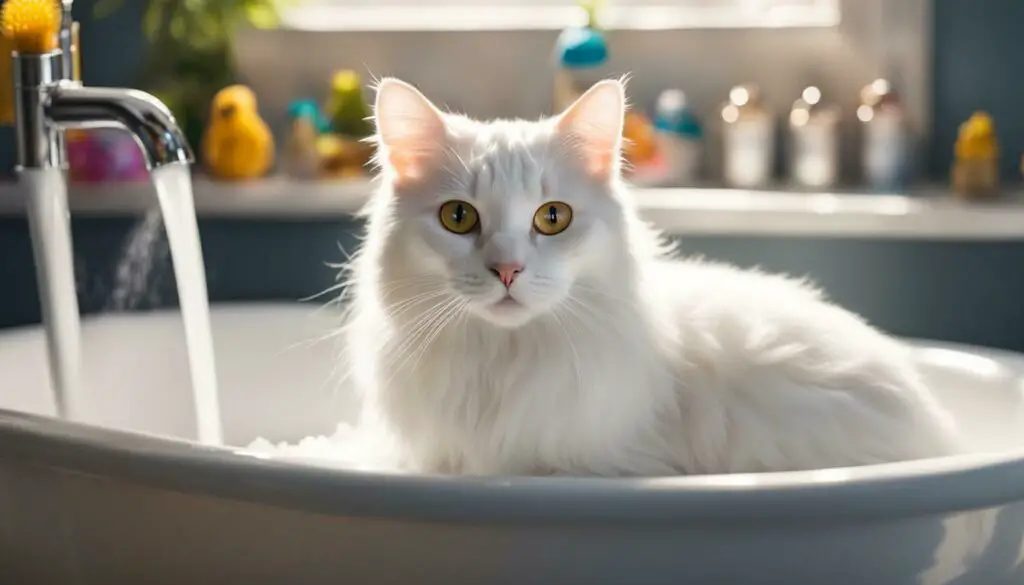
In conclusion, bathing a cat can have several benefits for their health and hygiene. However, it is important to consider each cat’s individual needs and preferences. Regular baths, using appropriate shampoos and techniques, can help prevent diseases, improve skin health, and maintain a clean coat. Alternatives such as pet wipes or dry shampoos can also be used to keep a cat clean if bathing is not suitable for the cat or owner. Ultimately, the goal is to provide the best care for the cat while respecting their comfort and well-being.
Frequency of Cat Baths
The frequency of cat baths depends on various factors, and it’s important to find the right balance for your cat’s individual needs. While cats are generally clean animals, their self-grooming may not be sufficient to remove all dirt, dust, and dead hair from their fur. Regular bathing can help maintain their hygiene and prevent certain issues, such as matting and skin irritations.
Experts recommend bathing cats once every 2-3 months to keep their coat healthy and shiny. However, it’s crucial to consider specific factors when determining the frequency of baths for your feline friend. These factors include the level of contamination, the cat’s age, medical conditions, stress levels, and existing grooming habits. For example, a cat that spends most of its time indoors and shows no signs of skin problems may require fewer baths compared to an outdoor cat or one with specific medical conditions.
The bathing process should be approached with care and proper technique. Use cat-specific shampoos that are mild and gentle on their sensitive skin. It’s important to maintain a warm environment during the bath to keep the cat comfortable and minimize stress. Introduce the cat to water gradually, allowing them to become familiar and relaxed with the sensation. Remember, bathing should be a positive experience for both you and your cat.
While some cats may tolerate and even enjoy baths, it’s essential to respect the individual preferences of each cat. If your cat becomes highly stressed or anxious during bathing, it’s best to explore alternative methods to keep them clean. Pet wipes, wet washcloths, and dry shampoos can help remove dirt and freshen up your cat’s coat without the need for a full bath.

| Factors to Consider for Cat Bathing Frequency | Recommended Frequency |
|---|---|
| Indoor cat with no skin issues | Every 2-3 months |
| Outdoor cat or exposure to dirt | Every 1-2 months |
| Cats prone to skin allergies or dermatitis | As advised by a veterinarian |
| Elderly cats or those with mobility issues | As required, with precautions |
| Stressed or anxious cats | Explore alternative cleaning methods |
Remember, observing your individual cat’s needs and preferences is crucial when determining the frequency of baths. Regular grooming, such as brushing and combing, can also help maintain their coat and reduce the need for frequent bathing. By finding the right balance, you can ensure your cat stays clean and comfortable without causing unnecessary stress.
Best Practices for Cat Bathing
To ensure a successful cat bathing experience, it’s essential to follow some best practices. Here are some tips and techniques to make the process smoother and more enjoyable for both you and your feline friend.
1. Choose the Right Shampoo
When bathing your cat, it’s important to use a shampoo specifically formulated for cats. Avoid using human shampoo or other harsh products, as they can strip the natural oils from your cat’s skin. Look for a gentle and tear-free shampoo that is designed to maintain the pH balance of your cat’s skin.
2. Create a Calm and Warm Environment
Prior to bathing, prepare a warm and quiet area where your cat can feel relaxed. Consider using a bathroom or a small space where your cat feels secure. Place a non-slip mat or towel in the tub or sink to provide stability for your cat and prevent accidents.
3. Gradual Introduction to Water
Start by allowing your cat to get comfortable with the bathing area before introducing water. Let your cat explore, sniff, and become familiar with the surroundings. Once your cat is relaxed, gently introduce warm water, using a handheld sprayer or a cup. Gradually wet your cat’s fur, starting from the neck and working your way down.
4. Be Gentle and Patient
During the bathing process, be gentle and patient with your cat. Speak softly and offer reassurance to help keep your cat calm. Use slow, deliberate movements and avoid rushing through the process. If your cat becomes anxious or stressed, take a break and try again later or on another day. Remember, positive reinforcements such as treats and praises can go a long way in creating a positive bathing experience for your cat.

5. Thoroughly Rinse and Dry
After shampooing, make sure to thoroughly rinse your cat’s fur to remove any remaining product. Leftover shampoo can cause skin irritation and lead to discomfort. Once rinsed, gently pat your cat dry with a clean towel. Avoid using a blow dryer, as the noise and heat can be distressing for most cats. Instead, let your cat air dry in a warm, draft-free environment.
Following these best practices can make the cat bathing experience more pleasant and effective. However, it’s important to remember that not all cats enjoy or tolerate baths. If your cat is especially fearful or resistant to bathing, consider seeking professional help or exploring alternative methods to keep your cat clean and groomed.
Considering Your Cat’s Preference
While some cats may enjoy being bathed, others may find it highly stressful. Each cat has unique preferences and temperaments when it comes to water and grooming. It is essential to respect your cat’s comfort level and make the bathing experience as positive as possible.
Creating a Positive Bathing Environment
To ensure a smoother bathing process, it is important to create a calm and comfortable environment for your cat. Choose a warm, quiet room with minimal distractions. Consider using a non-slip mat or towel in the bathtub or sink to provide stability and prevent your cat from slipping.
Introduce your cat to water gradually, starting with small amounts and using a gentle approach. Use treats, praise, and rewards to associate bathing with positive experiences. This will help your cat feel more at ease and build trust with you during bath time.
| Tip: | Place a towel or washcloth beneath your cat’s paws in the water to provide a sense of security and stability. |
|---|
Gentle Handling and Proper Techniques
When bathing your cat, it is important to handle them gently and avoid causing any distress. Use a cat-specific shampoo that is mild, hypoallergenic, and free of strong fragrances. Avoid getting water and shampoo in your cat’s eyes, ears, and mouth.
Start by wetting your cat’s fur gradually, using a spray bottle or a damp cloth. Apply the shampoo and gently massage it into the fur, being careful not to tug or pull on any mats or tangles. Rinse thoroughly to remove all traces of shampoo.
| Tip: | Having a helper can make the bathing process easier, especially for larger or more resistant cats. It allows one person to hold and comfort the cat while the other person does the washing. |
|---|
Post-Bath Care and Drying
After the bath, make sure to dry your cat thoroughly using a soft towel. Use a gentle, patting motion to prevent any discomfort or skin irritation. If your cat is comfortable with the noise, you can also use a low-heat blow dryer on the cool setting to speed up the drying process.
Avoid exposing your cat to cold drafts or chilly environments until they are completely dry. This will help prevent them from getting cold or developing skin issues. Additionally, reward your cat with treats or playtime after the bath to reinforce positive associations with the experience.
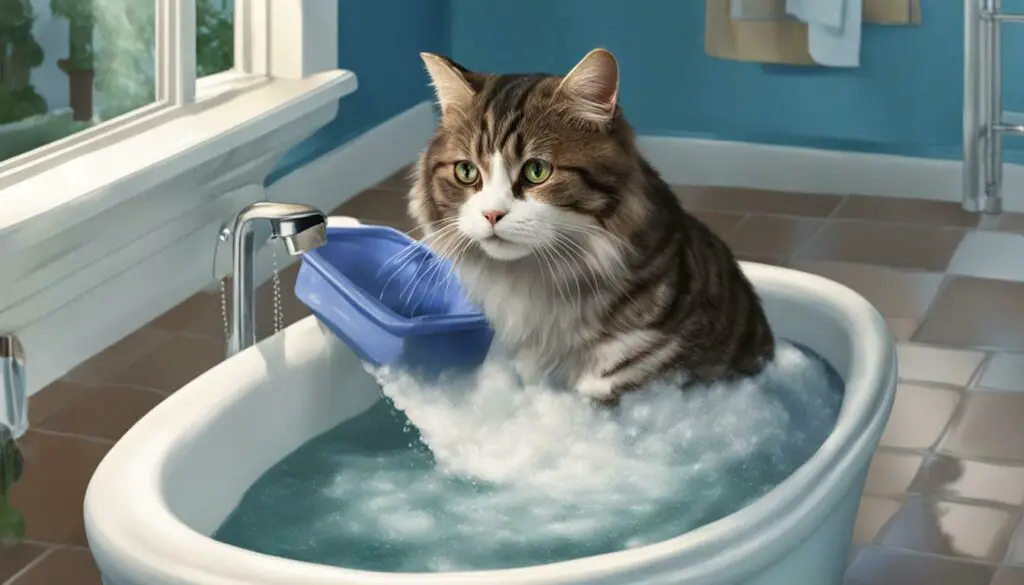
Bathing a cat at home can be a rewarding experience for both you and your feline companion. By considering your cat’s preferences, creating a positive environment, and using gentle handling techniques, you can help make bath time a more enjoyable and stress-free experience.
Alternatives to Full Baths
Full baths are not the only option for maintaining a cat’s cleanliness – there are alternative products and methods available. These alternatives can be particularly useful for cats who dislike water or become stressed during bath time. Let’s explore some of the options:
- Pet wipes: These convenient wipes are specially formulated to clean and freshen a cat’s coat. They are pre-moistened with gentle cleansers and can effectively remove dirt and odor. Simply wipe the cat’s fur with the pet wipes, focusing on areas that require extra attention, such as the paws or rear end. Pet wipes are particularly useful for quick touch-ups between baths.
- Wet washcloths: Similar to pet wipes, wet washcloths can be used to spot-clean your cat’s fur. Wet the washcloth with warm water and gently wipe the areas that need cleaning. For stubborn dirt or stains, you can add a small amount of cat-safe shampoo to the washcloth before wiping.
- Dry shampoos: Dry shampoos come in powder or foam form and are designed to clean the cat’s coat without the need for water. Simply apply the dry shampoo to the cat’s fur and massage it in. The shampoo will absorb dirt and grease, which can then be brushed out. Dry shampoos are ideal for cats who have sensitive skin or dislike water.
When using alternative methods to bathe your cat, it is important to choose products that are specifically formulated for feline use. Avoid using human shampoos or cleaning products, as they can be too harsh for a cat’s delicate skin and may cause irritation. Always read the product instructions and consult with your veterinarian if you have any concerns.

| Product | Description | Price |
|---|---|---|
| Cat Wipes | Gentle wipes with cat-safe cleansers | $10.99 |
| Washcloths | Soft and absorbent washcloths for spot cleaning | $6.99 (pack of 10) |
| Dry Shampoo | Powder or foam for waterless cleaning | $12.49 |
These alternative products and methods provide effective solutions for keeping your cat clean and fresh. Whether you choose to give your cat a full bath or opt for these alternatives, always prioritize their comfort and well-being. Remember to introduce new grooming routines gradually and reward your cat with treats and praise to create a positive association with the cleaning process.
Cats and Natural Self-Cleaning
Cats are known for their grooming habits, but there are limits to what they can achieve through self-cleaning. While cats spend a significant amount of time licking themselves, their tongues are not able to remove all dirt, dust, sebum, and dander from their fur. This is especially true for cats that go outside or lie on furniture, as they may come into contact with more contaminants. Regular baths can help to remove these substances, promoting optimal hygiene and preventing the spread of diseases.
However, it is important to note that not all cats enjoy being bathed. Some cats find the experience highly stressful and may resist, making it important to respect their comfort level. Creating a positive bathing environment and gradually introducing them to water can help reduce their anxiety. It’s also worth mentioning that there are alternative methods for keeping cats clean, such as using pet wipes, wet washcloths, and dry shampoos. These options can be useful for cats who are particularly averse to water or for giving them a quick refresh between baths.
To maintain a healthy coat and overall appearance, it is generally recommended to bathe cats once every 2-3 months. The frequency should be adjusted based on factors such as the degree of contamination, the cat’s age, medical conditions, stress levels, and existing grooming habits. When bathing a cat, it’s crucial to use appropriate shampoos that are specifically formulated for cats. Additionally, keeping the bathing environment warm and comfortable can help make the experience more pleasant for both you and your feline friend.
Benefits of Bathing Outdoor Cats
For cats that spend time outdoors, regular baths are particularly important. Outdoor cats are more likely to come into contact with dirt, parasites, and allergens, which can be problematic for both the cat and their human companions. Bathing can help remove these substances, reducing the risk of infestations and allergic reactions. It is advised to bathe outdoor cats more frequently, especially after they have been outside for extended periods of time or in environments with high contamination levels.
| Bathing Frequency | Suggested Bathing Routine |
|---|---|
| Weekly | Outdoor cats that frequently explore dirty or contaminated environments |
| Every 2-3 weeks | Outdoor cats with average exposure to dirt and allergens |
| Once a month | Outdoor cats with minimal exposure to dirt and allergens |
Bathing a cat with medical conditions or mobility issues requires extra care and attention. It’s important to consult with a veterinarian to ensure the bathing process is safe and suitable for their specific needs. Additionally, assessing a cat’s stress levels and taking steps to minimize anxiety during bath time can help create a more positive experience for both you and your furry companion.

Overall, while bathing a cat can have numerous benefits for their health and hygiene, it’s essential to consider their individual needs and preferences. Regular bathing, supplemented with alternative cleaning methods when necessary, can help keep cats clean, healthy, and comfortable.
Benefits of Bathing Outdoor Cats
Cats that go outside often require more frequent bathing to keep them clean and healthy. When cats roam outdoors, they can come into contact with various contaminants, including dirt, parasites, and allergens. Regular baths help remove these substances from their fur, reducing the risk of skin irritations, infections, and the spread of diseases.
Outdoor cats also tend to shed more due to exposure to the elements. Bathing helps remove dead hair from their coat, preventing matting and reducing the amount of shedding around your home. This can be particularly beneficial for individuals with allergies, as bathing can help reduce the presence of allergens in the environment.
Furthermore, bathing outdoor cats can improve their overall appearance. It can enhance the shine and cleanliness of their fur, making them look well-groomed and healthy. A clean and well-maintained coat also helps protect the cat’s skin and can contribute to their overall well-being.
When bathing outdoor cats, it is important to use cat-friendly shampoos and ensure a warm and comfortable environment to minimize stress. Gradually introducing them to the bathing process can also help make it a more positive experience for both you and your feline companion.

As with any cat, it is essential to monitor your outdoor cat’s stress levels and preferences when it comes to bathing. Not all cats enjoy being bathed, and forcing them can increase their anxiety and make the experience unpleasant for both of you. If your cat shows significant distress during the bathing process, consider alternative methods of keeping them clean, such as pet wipes or dry shampoos.
In summary, bathing outdoor cats can provide several benefits, including removing dirt and contaminants, reducing shedding and allergens, and improving their overall appearance and hygiene. However, it is important to consider your cat’s individual needs and preferences, and always prioritize their comfort and well-being when deciding whether or not to bathe them.
Cat Bathing and Allergies
Cat baths can be beneficial for individuals with allergies, as they help reduce the presence of allergens in the home. Cats produce a protein called Fel d 1, which is found in their saliva, skin, and urine. This protein is a common allergen for many people, causing allergic reactions such as sneezing, itching, and difficulty breathing. Giving your cat regular baths can help wash away the allergens from their fur, reducing the amount of Fel d 1 in the environment. This can significantly alleviate allergy symptoms and improve the overall quality of life for both the allergic person and the cat.
When bathing a cat to reduce allergens, it is important to follow a few tips for cat bathing. Firstly, use a cat-friendly shampoo that is specifically formulated for their sensitive skin. Avoid using human shampoos, as they can be too harsh and cause skin irritation. Additionally, make sure to rinse the shampoo thoroughly to remove any residue that may also cause allergic reactions. During the bathing process, it is advisable to wear gloves to minimize direct contact with allergens and to prevent skin irritation or allergic reactions.
While cat bathing can be an effective way to reduce allergens, it is important to note that some cats may find the bathing process stressful. It is crucial to create a calm and comfortable environment for them during baths. Gradually introduce your cat to water, using a shallow basin or sink filled with lukewarm water. Use gentle, slow movements to prevent startling or overwhelming them. Providing treats or positive reinforcement can help create a positive association with bathing, making the experience more enjoyable for both you and your cat.
Remember, regular cat bathing is not suitable for every cat, especially those with certain medical conditions or extreme stress levels. If your cat shows signs of discomfort or intense anxiety during baths, it may be best to explore alternative methods of reducing allergens, such as regularly brushing their fur, using pet wipes, or consulting with a veterinarian for further advice.
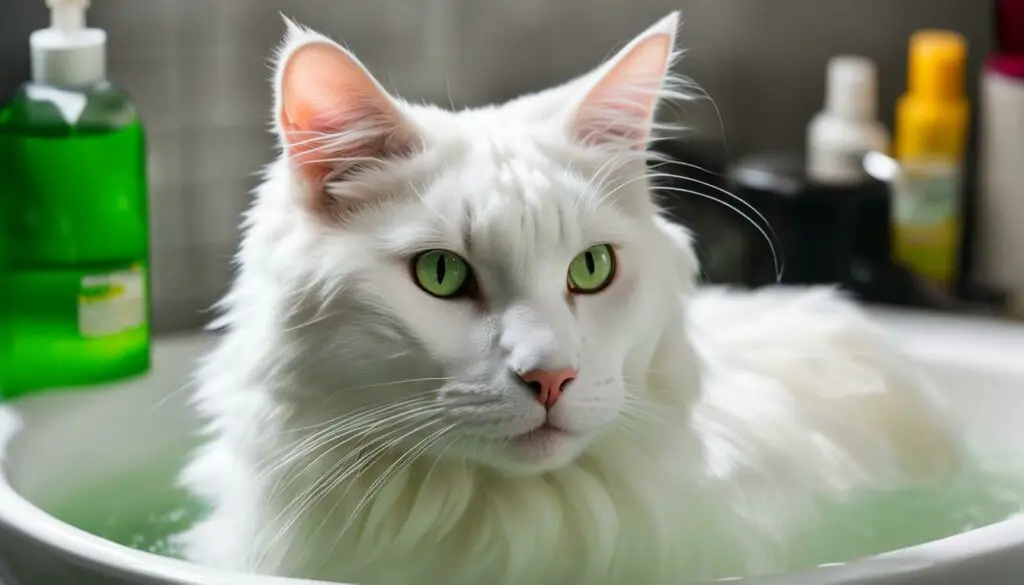
| Benefits of Cat Bathing for Allergies: |
|---|
| Reduces the presence of allergens in the home |
| Alleviates allergy symptoms such as sneezing and itching |
| Improves the overall quality of life for both the allergic person and the cat |
The Importance of Proper Drying
After bathing a cat, proper drying is essential to ensure their comfort and prevent any potential skin problems. Cats may become uncomfortable if they are left wet for too long, and excess moisture can lead to skin irritation and even fungal or bacterial infections. To avoid these issues, it is important to thoroughly dry your cat’s fur after a bath.
One effective method is to gently towel-dry your cat’s fur, using a soft towel or cloth. Start by patting the fur to remove excess water, being careful not to rub or pull on it. If your cat tolerates it, you can also use a hairdryer on a low heat setting, making sure to keep it at a safe distance to prevent overheating or scaring your cat. The hairdryer should be used sparingly and never pointed directly at the cat’s face or ears.
Avoid leaving wet spots on your cat’s fur, as this can lead to matting or tangling. Take the time to carefully dry all areas, including the underbelly, paws, and tail. If necessary, gently comb through the fur with a wide-toothed comb to remove any tangles or knots that may have formed during the drying process.
Remember, drying your cat after a bath is just as important as the bathing itself. By taking the time to properly dry your cat’s fur, you can ensure their comfort and maintain their skin health. A clean and dry coat will not only keep your cat looking their best but also contribute to their overall well-being.
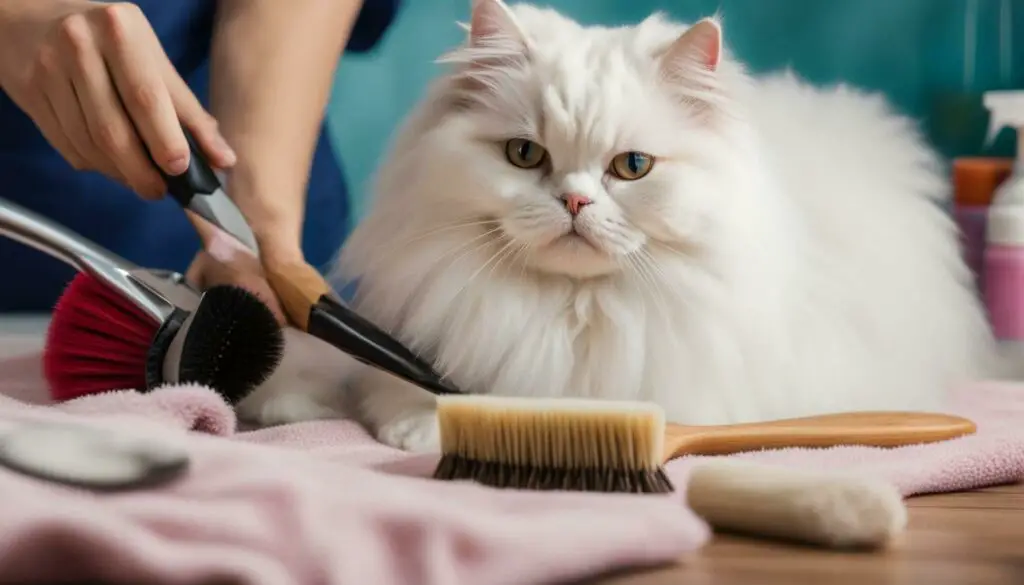
Bathing Cats with Medical Conditions
Cats with medical conditions require special considerations when it comes to bathing. It is important to consult with your veterinarian before attempting to bathe a cat with a pre-existing health condition. They can provide guidance on the safest and most appropriate bathing methods for your cat’s specific needs.
Bathing a cat with medical conditions may require extra care and precautions to ensure their comfort and well-being. Some cats with skin allergies or sensitivities may benefit from hypoallergenic shampoos or medicated baths prescribed by a veterinarian. It is crucial to follow the vet’s instructions and avoid using any products that could irritate or worsen the cat’s condition.
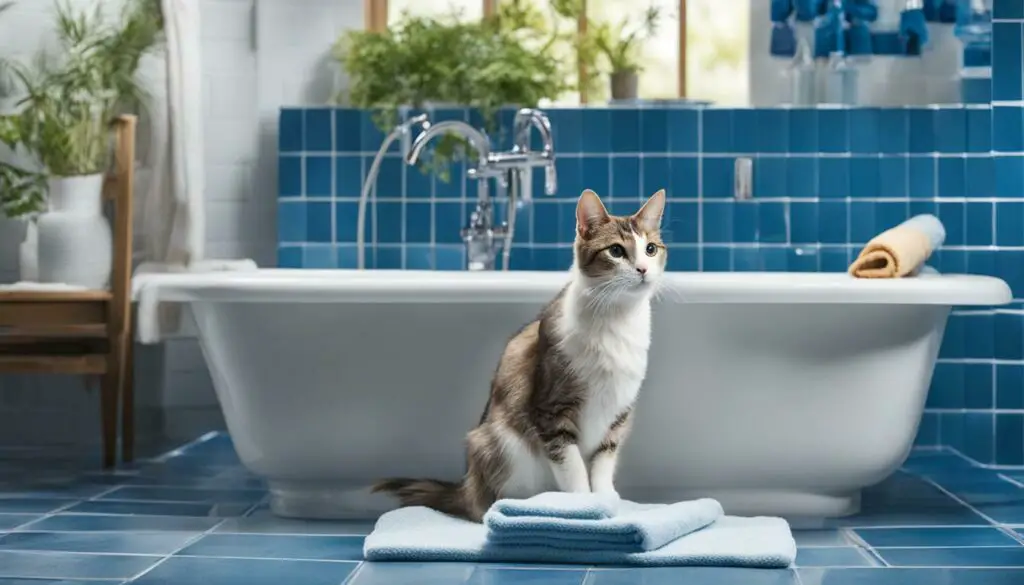
In some cases, it may be necessary to avoid bathing the cat altogether and explore alternative grooming methods. This could include using pet wipes or gentle brushing to maintain cleanliness and hygiene without the need for a full bath. Your veterinarian can recommend the most suitable grooming routine based on your cat’s specific condition and needs.
Remember, a cat’s well-being and comfort should always be the top priority. Take the time to understand your cat’s medical condition and work with your veterinarian to develop a bathing routine that meets their individual needs. With proper care and attention, you can help keep your cat clean and healthy while ensuring their bathing experience is as stress-free as possible.
Assessing Your Cat’s Stress Levels
Assessing your cat’s stress levels is crucial when it comes to bathing them at home. Cats are known for their independent nature and can be easily stressed by unfamiliar situations or environments. Understanding your cat’s behavior and body language can help you create a positive and stress-free bathing experience for them.
One way to assess your cat’s stress levels is to observe their body posture and vocalizations. If your cat is displaying signs of distress, such as flattened ears, dilated pupils, growling, or hissing, it may indicate that they are feeling anxious or threatened. In this case, it is important to proceed with caution and avoid forcing them into the bath.
Creating a calm and comfortable bathing environment can also help reduce your cat’s stress levels. Ensure that the bathing area is warm, quiet, and free from distractions. Place a non-slip mat in the tub or sink to provide stability for your cat and prevent any slips or accidents. It is also helpful to use a gentle and soothing tone of voice when interacting with your cat during the bathing process.
Remember, not all cats enjoy being bathed, and some may find it extremely stressful. If you find that your cat becomes overly anxious or agitated during bath time, it may be best to explore alternative methods of keeping them clean, such as pet wipes or dry shampoos. Always prioritize your cat’s well-being and choose the bathing method that works best for them.

Summary:
- Assess your cat’s stress levels before bathing them.
- Observe body language, vocalizations, and signs of distress.
- Create a calm and comfortable bathing environment.
- Use a gentle and soothing tone of voice.
- Explore alternative cleaning methods if necessary.
Conclusion
Bathing a cat can have significant benefits for their health and hygiene, but it should be approached with consideration for the individual cat’s needs and preferences.
According to experts in felinology, bathing a cat can help prevent diseases, moisturize and clean the skin, remove dead hair, and improve the overall health and appearance of the cat’s coat. However, it is important to note that not all cats require regular baths. Cats are generally clean animals, and their natural self-cleaning behavior can effectively remove dirt and debris from their fur. In some cases, such as cats that go outside or those that lie on furniture, regular baths may be beneficial to maintain optimal hygiene.
When deciding whether or not to bathe a cat, it is recommended to take several factors into consideration. The frequency of baths should be determined by the degree of contamination, the cat’s age, medical conditions, stress levels, and existing grooming habits. Experts recommend bathing cats once every 2-3 months to maintain a healthy and clean appearance. It is important to follow proper bathing techniques, including using appropriate shampoos, ensuring a warm and comfortable environment, and gradually introducing the cat to water to minimize stress.
However, it is crucial to respect the cat’s comfort level and not to force them into baths if they find it highly stressful. Some cats may actually enjoy the bathing process, while others may feel anxious or fearful. If bathing is not feasible or too stressful for a particular cat, alternatives such as pet wipes, wet washcloths, and dry shampoos can be used to keep them clean and fresh without the need for full baths.
In conclusion, while bathing a cat can be beneficial for their health and hygiene, it should always be done with consideration for the individual cat’s needs and preferences. Observing their behavior and comfort level, as well as consulting with a veterinarian, can help ensure that bathing is a positive experience for both the cat and their owner.
FAQ
Should I give my cat a bath?
Bathing a cat can have several benefits, such as disease prevention, improved skin health, and a cleaner coat. However, it is important to consider individual situations and the cat’s preferences before deciding to bathe them.
How often should I bathe my cat?
Cats should be bathed once every 2-3 months, taking into account factors like contamination, age, medical conditions, stress levels, and existing grooming habits.
What are the best practices for cat bathing?
It is recommended to use appropriate shampoos, maintain a warm environment, and gradually introduce the cat to water during the bathing process.
What if my cat doesn’t like baths?
It is important to respect the cat’s comfort level and not to force them if they find bathing highly stressful. Creating a positive bathing environment and using alternatives to full baths, such as pet wipes or dry shampoos, can be helpful.
Can I use alternatives to full baths to keep my cat clean?
Yes, pet wipes, wet washcloths, and dry shampoos can be used as alternatives to full baths to keep a cat clean without the need for frequent bathing.
Do cats clean themselves naturally?
Cats are generally clean animals, but their licking alone may not effectively remove dirt, dust, sebum, and dander from their fur.
Should I bathe outdoor cats more often?
Cats that go outside or lie on furniture may benefit from more frequent baths to remove dirt, parasites, and allergens they may come into contact with.
Can regular cat baths help reduce allergies?
Regular cat baths can help reduce allergens in the home, benefiting both allergic individuals and the cat themselves.
How important is proper drying after a bath?
Thoroughly drying a cat after a bath is important to prevent discomfort and skin issues.
How can I bathe a cat with a medical condition?
When bathing a cat with a medical condition, such as skin allergies or mobility issues, it is important to take their safety and well-being into consideration. Consulting with a veterinarian may be helpful.
How can I reduce my cat’s stress during bath time?
Gauge your cat’s stress levels and provide a calm and comfortable environment during bath time. Gradually introduce them to water and use calming techniques, such as gentle handling and soothing voices.








